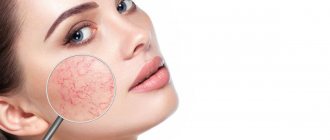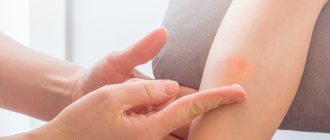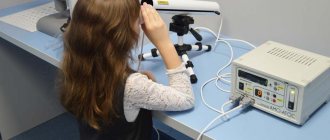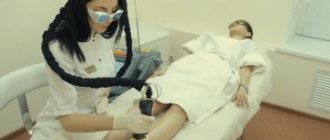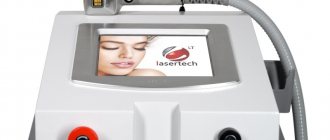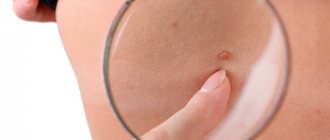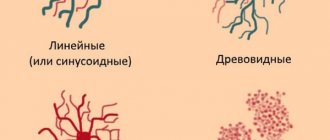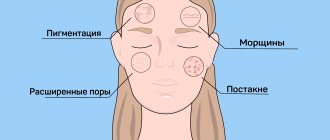Spider veins and hemangiomas
Dilated blood vessels, port-wine stains, spider veins (hemangiomas), rosacea are very common in the adult population. Due to dilated blood vessels on the face and body, a person looks unattractive, older than his age, and therefore may experience an inferiority complex. More often than on the face, spider veins are found on the lower extremities.
Spider veins (telangiectasia, telangiectasia), intradermal varicose veins, “branchy” veins - all these are different names for the same problem, which is called “spider veins” among patients. Single or multiple asterisks occur in every fourth woman aged 25-35 years, and after childbirth - in 80% of women. In a number of cases, this is a manifestation of the initial stages of varicose veins of the lower extremities.
Patients with spider veins sometimes complain of pain, tingling, a feeling of heat and leg cramps. Aesthetic (cosmetic) defect - bluish, reddish web on the legs and thighs.
Table of contents
- Etiology and pathogenesis
- Clinical manifestations
- Treatment methods
Port-wine stains, also called capillary angiodysplasia or flammeus , are one of the most common vascular malformations. They are a network of pathologically altered capillaries located superficially or deep under the skin and visible through it.
In our company you can purchase the following equipment for the treatment of wine stains:
- M22 (Lumenis)
According to world statistics, port-wine stains are registered on average in 0.1–2.0% of newborns. Most often they occur in representatives of the Caucasian race, with equal probability in both boys and girls.
Causes and treatment
Reasons for the development of spider veins and angiectosis:
- heredity,
- obesity,
- lifestyle (long-term static loads, heavy lifting, immobility in a standing or sitting position, etc.),
- hormonal imbalance,
- pregnancy.
Treatment of spider veins in our clinic is carried out using a modern diode laser. The diode laser effectively eliminates dilated blood vessels on the face and body, as well as port-wine stains and hemangiomas (spider veins).
The effect is performed only on the problem area, without damaging surrounding tissues and is practically painless.
It is important that this procedure completely eliminates any adverse effects on the skin; laser radiation “glues” the walls of the vessel: as a result, we get an excellent aesthetic effect - clean, healthy skin.
Laser procedures for the treatment of vascular skin diseases are easily tolerated, so patients do not require anesthesia. Minor redness of the skin in the treated area that appears immediately after the procedure usually disappears completely within 15 to 30 minutes.
The blood vessel is “sealed” without damaging the surrounding skin. Laser procedures to remove spider veins and treat hemangiomas and port-wine stains are easily tolerated, so patients, even the smallest ones, do not require anesthesia. During the procedure, adverse effects on the tissue surrounding the vessel are completely eliminated. The risk of scarring is also completely eliminated.
Removal of vessels up to 2 mm. in diameter (telangiectasia) on the face and body. When a laser is applied to the skin, the light energy is absorbed by the pigment of the blood vessel. As a result, the walls of the vessel stick together, and it disappears into the thickness of the skin. Small vessels are removed without a trace, large vascular spots, hemangiomas turn pale and significantly decrease in size.
Removing wine stains. It is difficult to overestimate the wonderful aesthetic effect that photocoagulation provides when treating (removing) so-called “port-wine stains.” There is currently no alternative to such a laser procedure.
Treatment of rosacea. Excellent results using laser can be achieved in the treatment of rosacea, not only in the initial stage of the disease, but also with long-term existence of the pathological process. The procedure is painless due to the built-in cooling system and takes from several minutes to half an hour. Sometimes “bruises” remain at the site of a vascular or pigmented spot, which disappear on the 3-5th day. The course of treatment is individual, prescribed by a doctor, and consists of 2-3 procedures.
Etiology and pathogenesis of port-wine stains
In most cases, port-wine stains (nevus flaminga) are a birth defect . They are present in the baby immediately after birth and increase in size in proportion to the further growth of the child. An important feature of port-wine stains is the lack of spontaneous regression - they form for a lifetime and, as a rule, have a negative impact on a person’s psychological state.
In rare cases, port-wine stains may appear on apparently healthy skin in adulthood - this is the so-called acquired capillary angiodysplasia . Sometimes port-wine stains may not be an independent pathology, but signs of severe syndromes: Sturge-Weber (encephalotrigeminal angiomatosis with damage to the pia mater) or Klippel-Trenaunay (vein malformations with hypertrophy of bones and soft tissues).
The International Society for the Study of Vascular Anomalies (ISSVA) classifies capillary angiodysplasia according to the predominant vessel type—arterial, venous, lymphatic, capillary, or complex.
Benefits of laser treatment
Advantages of a diode laser for removing vascular pathologies of the skin:
- safe and painless procedure;
- high efficiency;
- no scar or skin pigmentation is formed at the site of removal;
- lack of rehabilitation period;
- short duration of the procedure;
- fast and excellent aesthetic results.
Laser removal of vascular skin pathologies is becoming increasingly popular, due to the large number of advantages and very few contraindications of this procedure.
How to get rid of rosacea
The use of advanced technologies to eliminate rosacea contributes to the possibility of getting rid of aesthetic defects in minimally invasive ways. The most effective among them is laser coagulation of blood vessels. The advantages of laser star removal include:
- The method is painless, apart from a slight tingling sensation. There is no need for anesthesia during laser removal of blood vessels.
- Preservation of the integrity of the skin, absence of traces in the form of wounds, stitches, etc.
- Efficiency. The speed of the session depends on the number of vessels to be removed by the laser.
- Quick results. In the vast majority of patients, just one session is enough, after which the damaged vessels will disappear in a few days.
Disease: telangiectasia
Treatment method: Laser therapy (LimeLight)
Upon examination of the patient, varicose veins were diagnosed. Laser therapy was performed.
Disease: telangiectasia
Treatment method: Laser therapy (LimeLight)
Upon examination of the patient, varicose veins were diagnosed. Laser therapy was performed.
Disease: telangiectasia
Treatment method: Laser therapy (Tru Pulse)
Upon examination of the patient, varicose veins were diagnosed. Laser therapy was performed.
Disease: telangiectasia
Treatment method: Laser therapy (Tru Pulse)
Upon examination of the patient, varicose veins were diagnosed. Laser therapy was performed.
Disease: telangiectasia
Treatment method: Laser therapy (Tru Pulse)
Upon examination of the patient, varicose veins were diagnosed. Laser therapy was performed.
Disease: telangiectasia
Treatment method: Laser therapy (Tru Pulse)
Upon examination of the patient, varicose veins were diagnosed. Laser therapy was performed.
Disease: telangiectasia
Treatment method: Laser therapy (Tru Pulse)
Upon examination of the patient, varicose veins were diagnosed. Laser therapy was performed.
Disease: telangiectasia
Treatment method: Laser therapy (Tru Pulse)
Upon examination of the patient, varicose veins were diagnosed. Laser therapy was performed.
| Fill out an application on the website, we will contact you shortly. Or call us at +7(495) 967-94-42 |
Vascular pathology: what factors cause it?
Risk factors associated with poor circulation include:
- hypertension;
- high levels of triglycerides and “bad” cholesterol (LDL) in the blood;
- low blood levels of “good” cholesterol (HDL);
- smoking;
- diabetes;
- obesity;
- physical inactivity.
To prevent vascular diseases, it is recommended to maintain a healthy diet, eat fruits and vegetables, and minimize the consumption of fats and sugar. You should also quit smoking and lead an active lifestyle and exercise periodically. It is really useful for blood circulation and combating venous insufficiency.
Digestive diseases
Diseases of the gastrointestinal tract can indirectly affect vascular health. Irritation from the mucous membrane of the gastrointestinal tract is transmitted through the branches of the vagus nerve to its nuclei, the excitation passes to the nearby nuclei of the trigeminal nerve and through the branches of the latter enters the central zone of the face, causing vasodilation.
Recent studies confirm that the bacteria Helycobacter pylori persisting in the gastric mucosa contributes to the disruption of neurochemical regulatory mechanisms, which in turn lead to vasodilation.
Sharp fluctuations in high and low temperatures
The effect of cold on the condition of blood vessels should not be underestimated - the first reaction to a decrease in temperature is a sharp vasospasm in order to reduce heat transfer. Subtle mechanisms of autonomic regulation are activated, followed by compensatory vasodilation.
Many clinical symptoms of prerosacea and rosacea develop through this mechanism.
The autonomic nervous system has both direct and indirect effects on the microvasculature. Normally, the vasoconstrictor effect is exerted by norepinephrine, which acts on alpha-1 adrenergic receptors; vasodilator - adrenaline acting on beta-2 adrenergic receptors of smooth muscle cells of arterioles.
The production of acetylcholine is accompanied by dilation of the vessel and an increase in the speed of blood flow in it (due to stimulation of NO production through M receptors). This vascular response is called endothelium-dependent dilation. A mechanism of endothelium-dependent vasoconstriction associated with the synthesis of endothelin-1 and 20-HETE in the endothelium is also identified.
Autonomic dysfunctions contribute to disruption of homeostasis and adaptation of the body to various environmental influences and lead to disruption of the skin structure, increased permeability of the vascular wall, decreased barrier functions of the epidermis and create conditions for the development of inflammation in the skin.
Many clinical symptoms of prerosacea and rosacea develop through this mechanism.

